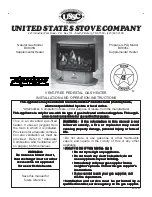
TM081 Rheem 834 Series Hydroelectric CFGWH Service Instructions
REV: AA Issued: 22/02/17
This document is stored and maintained electronically by Rheem Technical Support. All printed copies are deemed uncontrolled.
11
5. The ignition module
(8)
checks to ensure a pilot
(11)
flame is present via the flame
sensor
(9)
. If a pilot flame is not detected (> 0.5 µA) within 45 seconds, fault indication
is provided and the heater will not operate until it has been reset (hot tap turned off
and then back on) at which time it will restart from step 1. If a pilot flame (> 0.5 µA) is
detected before expiry of the 45 second ignition period, the ignition rod
(10)
and SV1
(12)
are de-energised and operation will continue from the next step.
6. SV2
(6)
and SV3
(7)
are energised after a four second delay allowing gas to travel to
the main burner
(5)
which cross lights on low fire from the pilot
(11)
(low fire due to the
MASV already being driven to the minimum opened minimum gas rate position in step
2).
Note:
Although SV1 was de-energised in the previous step, the pilot is still supplied
residual gas from the pilot chamber inside the gas valve. The pilot will extinguish when
the remainder of the residual gas is pushed out by the opening of the main burner
valve SV2 (after approximately 2 seconds).
7. The main burner
(5)
is now operating and heating the water flowing through the heat
exchanger
(13)
. Air for combustion enters the heater via the air intake louvre
(14)
and
hot flue gasses exit the heater by natural draught via the flue terminal
(15)
.
8. The temperature controller
(3)
detects the hot water outlet temperature via the hot
water outlet temperature sensor
(16)
and drives the MASV
(4)
up or down to obtain the
setpoint temperature i.e. lower hot water outlet temperature equals more gas and
higher hot water outlet temperature equals less gas.
Temperature control note:
If the
water flow rate through the
heater is reduced by ≥ 1.4L/m, the pilot
(11)
will light (SV1
(12)
energised), the main burner
(5)
will extinguish (SV21
(6)
& SV3
(7)
de-energised),
the MASV will readjust and the main burner will relight (SV2 & SV3 energised) and
pilot extinguish (SV1 de-energised) after a two second delay. This function prevents a
slug of over temperature hot water being supplied to the hot water outlet.
Main burner operation and temperature control continues in this manner until one of
the following occurs:
9a.
The water flow rate through the heater becomes < 2.7 L/m:
i.e. all hot taps are
closed or water flow rate through the heater is insufficient. The hydro electric generator
(1)
ceases to generate a voltage, SV2
(6)
and SV3
(7)
are de-energised which results
in a main burner
(5)
shut down, the ignition module
(8)
is de-energised, battery
(17)
recharge and water throttle valve
(18)
functions are terminated if on (these will be
explained later in this section), the temperature controller
(3)
green LED is
extinguished and if the battery voltage is > 3.1 VDC the MASV
(4)
is driven to the
minimum opened (minimum gas) position. SV1
(12)
is also de-energised if on. If the
water flow rate increases to > 3 L/m operation will recommence from step 2.
9b.
A flame failure occurs:
First loss of fame signal within a water flow cycle:
SV2
(6)
and SV3
(7)
are de-
energised which results in a main burner
(5)
shut down. The MASV
(4)
is driven to the
minimum opened (minimum gas) position and a re-ignition attempt is performed
starting from step 4.
Second loss of fame signal within a water flow cycle:
SV2
(6)
and SV3
(7)
are de-
energised which results in a main burner
(5)
shut down. The ignition module
(8)
is de-
energised, battery
(17)
recharge and water throttle valve
(18)
functions are terminated
(these will be explained later in this section) and fault indication is provided. If the
battery voltage is > 3.1 VDC the MASV
(4)
is driven to the minimum opened (minimum
gas) position. SV1
(12)
is also de-energised if on. The heater will not operate until it
has been reset (hot tap turned off and then turned back on) at which time the heater
will restart from step 1.












































